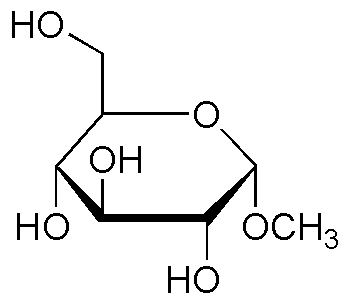Methyl-a-D-glucopyranoside is widely utilized in research focused on:
- Food Industry: Used as a sweetener and flavor enhancer in various food products, providing a natural alternative to synthetic sweeteners.
- Pharmaceuticals: Acts as a stabilizer and excipient in drug formulations, improving the solubility and bioavailability of active ingredients.
- Biotechnology: Serves as a carbon source in microbial fermentation processes, aiding in the production of biofuels and biochemicals.
- Cosmetics: Incorporated in skincare products for its moisturizing properties, enhancing the texture and hydration of creams and lotions.
- Research Applications: Utilized in glycosylation reactions in organic synthesis, facilitating the development of complex carbohydrates for various studies.
General Information
Properties
Safety and Regulations
Applications
Methyl-a-D-glucopyranoside is widely utilized in research focused on:
- Food Industry: Used as a sweetener and flavor enhancer in various food products, providing a natural alternative to synthetic sweeteners.
- Pharmaceuticals: Acts as a stabilizer and excipient in drug formulations, improving the solubility and bioavailability of active ingredients.
- Biotechnology: Serves as a carbon source in microbial fermentation processes, aiding in the production of biofuels and biochemicals.
- Cosmetics: Incorporated in skincare products for its moisturizing properties, enhancing the texture and hydration of creams and lotions.
- Research Applications: Utilized in glycosylation reactions in organic synthesis, facilitating the development of complex carbohydrates for various studies.
Documents
Safety Data Sheets (SDS)
The SDS provides comprehensive safety information on handling, storage, and disposal of the product.
Product Specification (PS)
The PS provides a comprehensive breakdown of the product’s properties, including chemical composition, physical state, purity, and storage requirements. It also details acceptable quality ranges and the product's intended applications.
Certificates of Analysis (COA)
Search for Certificates of Analysis (COA) by entering the products Lot Number. Lot and Batch Numbers can be found on a product’s label following the words ‘Lot’ or ‘Batch’.
*Catalog Number
*Lot Number
Certificates Of Origin (COO)
This COO confirms the country where the product was manufactured, and also details the materials and components used in it and whether it is derived from natural, synthetic, or other specific sources. This certificate may be required for customs, trade, and regulatory compliance.
*Catalog Number
*Lot Number
Safety Data Sheets (SDS)
The SDS provides comprehensive safety information on handling, storage, and disposal of the product.
DownloadProduct Specification (PS)
The PS provides a comprehensive breakdown of the product’s properties, including chemical composition, physical state, purity, and storage requirements. It also details acceptable quality ranges and the product's intended applications.
DownloadCertificates of Analysis (COA)
Search for Certificates of Analysis (COA) by entering the products Lot Number. Lot and Batch Numbers can be found on a product’s label following the words ‘Lot’ or ‘Batch’.
*Catalog Number
*Lot Number
Certificates Of Origin (COO)
This COO confirms the country where the product was manufactured, and also details the materials and components used in it and whether it is derived from natural, synthetic, or other specific sources. This certificate may be required for customs, trade, and regulatory compliance.


